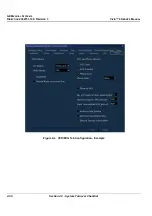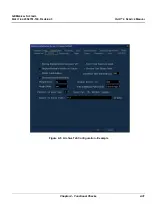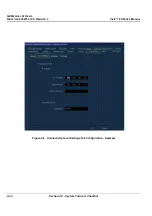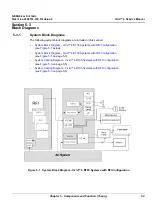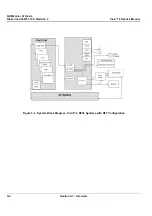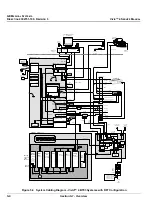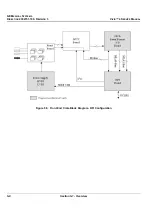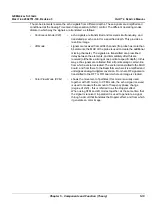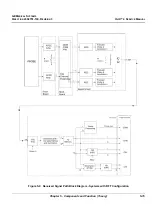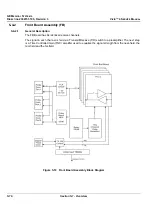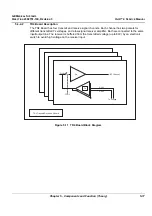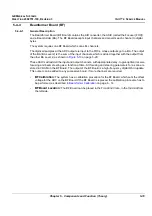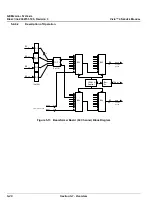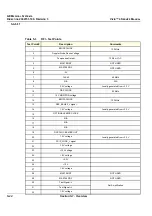
GE M
EDICAL
S
YSTEMS
D
IRECTION
2392751-100, R
EVISION
3
V
IVID
™ 4 S
ERVICE
M
ANUAL
5-10
Section 5-1 - Overview
5-4-1-1
Front End Bus
Most of the FE boards are controlled by the Front End Controller or RFI board via a Front End Bus
(FE_BUS). The FE_BUS is a synchronous and bidirectional bus built up by 16-bit data, 6-bit device
address select, 10-bit page address and 8 strobe signals controlling the data transactions. The Front
End Controller or RFI board can also read the revision status of the Front End boards through a serial
line I
2
C to an E
2
PROM located on each board, and some probes.
5-4-1-2
Phased and Linear Array Front End
•
The phased and linear array probes consist of several identical transducer elements (for example,
64, 128, 192). Three probes and a pencil probe can be connected to the system. The connectors
are physically located on the FB board, where one of them is selected and connected to the
transmitter (TX) and receiver (RX) through a number of relays.
•
Depending on probe type and system setup, a certain scan pattern is selected on the FEC (or RFI)
board. This board loads scan parameters for both the transmitter and the beamformer (steering-
and focusing delays) into local RAM on these boards. Thus, when the FEC (or RFI) board goes
through a scan sequence, it loads the proper contents of the RAM into the Transmitter Pulse
Generator (TPG), then issues a transmit trigger pulse (TXTRIG_L) for the transmitter and a receive
synchronization pulse (SYNC_L) for the beamformer. By firing the transmit pulses from the different
elements at certain repeated time intervals and with different delays, the ultrasound beam can be
steered in desired directions (re. principles of operation) obtaining the selected scan patterns (for
example, 2D, 2D Flow, etc.).
•
The ultrasound transmit bursts are generated on the Front board (FB), initiated by the transmit
trigger pulse (TXTRIG_L). The transmit trigger starts the Transmit Pulse Generators (TPG) on the
FB, each generating 16 transmit pulses with different delays. The transmit pulses are then routed
to separate transmit “amplifiers” fed with voltage HV1 and HV2 witch are controlled by the Acoustic
Power control software.
•
The transmit pulses are routed over TR4 boards located on the Front board (FB), where they are
fed to the selected (one out of three) phased/linear array probe.
•
The reflected signal from body structures and blood cells are routed from the probe, via the Front
board over the TR4 boards, where pre amplification (20dB) and Analog Time Gain Compensation
(ATGC) (-10 - +30 dB) is performed. Gain is determined by an analog signal (ATGC) generated by
the FEC (or RFI) board.
At the input to the Front board are transmit/receive (T/R) switches to prevent the transmitters from
destroying the receivers. Prior to pre amplification, the signals from the different channels were also
fed through relays. This provides the possibility to route echoes from annular array probes into the
receiver, in addition to injecting a test signal, TSIG.
•
The output channels from the TR4 boards are fed to the MUX board via one Beamformer-64 board.
The Beamformer board performs A/D conversion of 64 channels.
•
The Front End Controller board controls all Front End boards (on systems with the RFT
configuration). The board loads all parameters to the FB, MUX and Beamformer RAMs, it reads the
probe identification, selects probe connector on TR4 boards and controls the high voltage
multiplexer in linear probes. In addition, the board generates the following:
*
a transmit trigger pulse for TR4.
*
a receive synchronization pulse (SYNC_L) used by Beamformers and RF & Tissue
Processor.
*
a differential ATGC voltage used by TR4 and control signals for the High Voltage Power
Supply (HVPS).
*
system master clock generator (40 MHz).
*
a reset pulse (SRES).

